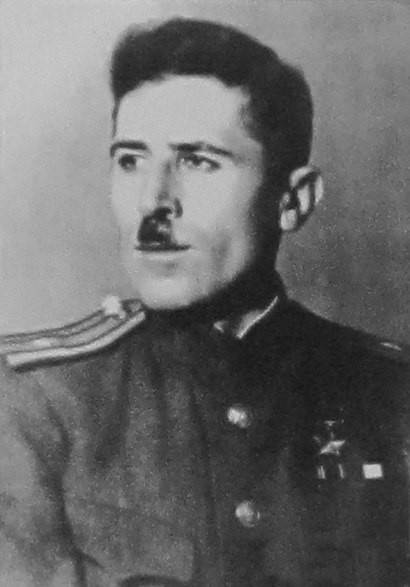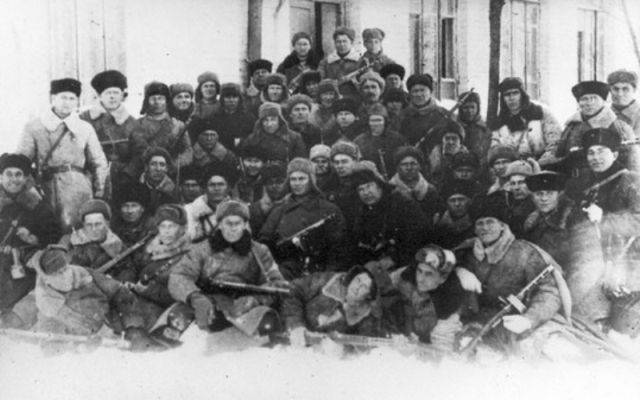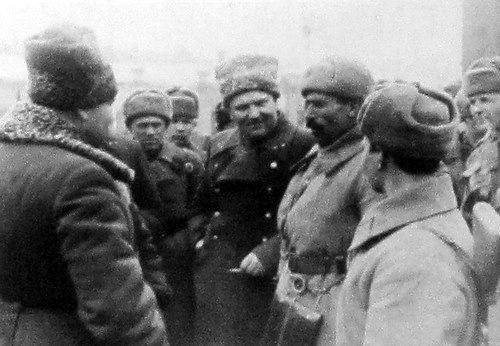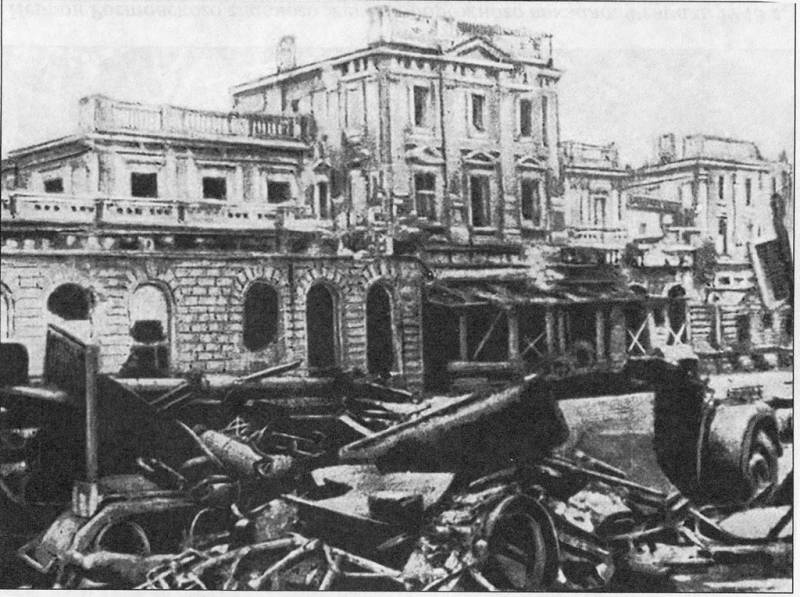Not one step back. The feat of commander Madoyana and the liberation of Rostov
The offensive of the Southern Front troops in the Rostov direction began as early as January 1, 1943, and three weeks later, units of the 28 Army commanded by Lieutenant General Vasily Gerasimenko reached the shores of the Don. Bataysk had to be occupied, and then, advancing from the left bank of the Don, Rostov was also to be liberated. In the area of the city center, the Don XXUMX Infantry Brigade of Lieutenant Colonel A.I. Bulgakov. In the evening of February 159, the 7 of the 1943 Rifle Brigade formed an assault squad which consisted of fighters from three brigade rifle battalions. They were faced with a very responsible and difficult task - to cross the Don River over the ice, to sneak into the city unnoticed and to seize the Rostov-on-Don railway station.
At approximately 01:30 on February 8, 1943, the Red Army of the 159th Brigade began to cross the Don. The reconnaissance detachment of Lieutenant Nikolai Lupandin shot the German sentries on duty on the banks of the Don. Two machine-gun crews of the Germans on the bridge and the control room were also destroyed. Having penetrated the city, the Red Army men occupied a site in the area of Bratsky lane, not far from the station. However, despite the night darkness, the Nazi patrols nevertheless saw Soviet soldiers crossing the Don. 200 Hitler’s machine gunners were raised by alarm, 4 German were sent to the embankment area tank. A battle ensued in which the commanders of two rifle battalions who were part of the assault group were seriously wounded - the commander of the 1st battalion, major M.Z. Diablo and the commander of the 4th battalion, captain P.Z. Derevyanchenko, many Red Army soldiers were killed or seriously injured. Soon Major Diablo received secondary injuries in the face and chest, and the deputy commander of the battalion A.F. was shocked. Kryukov, the company commander of submachine gunners N.Sh. Ipkaev, other brigade officers were injured.
- The station building in February 1943.
The only commander remaining in the ranks was Senior Lieutenant Gukas Madoyan, who commanded the 4 rifle battalion of the 159 rifle brigade. He took command of the assault detachment, more precisely, what was left of him after the battle in the city center. Under the authority of Madoyan, there were about 800 people - soldiers, sergeants and officers of three battalions. With these forces the battalion commander had to seize the railway station, waiting for the approach of the main forces of the Red Army. Thus began the heroic feat of Senior Lieutenant Madoyan and his subordinates, who even now, after 75 years after the liberation of Rostov-on-Don, the city residents remember with delight and gratitude.
Gukas Karapetovich Madoyan was not a Rostov citizen, but entered into history cities as a symbolic figure, the personification of the liberation of the "Gate of the Caucasus" from the Nazi invaders. He was born on January 15 1906, in the village of Kers, Kara region. Gukas' parents, Armenian peasants, died during the famous tragic events in Ottoman Turkey. But Gukasu was lucky to survive. After moving to Soviet Armenia, he received an incomplete secondary education, and in 15-year-old age he volunteered for the Red Army. Gukas Madoyan participated in the battles of the Civil War in Armenia and Georgia, and then, in 1924, he graduated from an infantry school. But soon Gukas left the Red Army and got a job as a head of the production department in a workers' cooperative.

Zhil Madoyan in Yerevan, where he worked in the sphere of national economy right up to 1940. In 1933-1937 He headed the Yerevan Department of Trade weapons, and in 1937-1940. was the head of the department in the grocery store of Yerevan. It seemed that Gukas Karapetovich would work in positions in the sphere of trade for the rest of his life. But in 1940, Madoyan again had to return to the system. The 34-year-old lieutenant was retrained in the “Shot” commanding courses, and when the Great Patriotic War began, he was appointed commander of the company of the mountain rifle regiment. 19 November 1942. Senior Lieutenant Madoyan was appointed commander of the 3 Infantry Battalion 159 Infantry Brigade of the 28 Army. He participated in the great battle of Stalingrad, in the battles for the liberation of Elista and other settlements.
Early in the morning of February 8, Soviet units attacked the entire right bank of the Don, occupied by Rostov-on-Don and its suburbs. Units of the 34 Guards Rifle Division and the 6 Panzer Division attacked the stanitsa of Nizhne-Gnilovskaya, the 152-Rifle Brigade fought in the area of Kirovsky Avenue, 156-Rifle Brigade on the Green Island, in the area of Aleksandrovka and Aksai - XNUM part Guards Mechanized Corps. In the meantime, the German command, realizing that the main task was to save trains with cargo and deliver them to Taganrog, decided to block the 3 battalions of the rifle brigade in the area of the suburban and main railway stations, which involved tanks and artillery.
In the lead of a squad of 800 Red Army soldiers of three rifle battalions, Senior Lieutenant Madoyan did not lose his head and ordered his subordinates to rush to the building of the railway station. As a result of a fierce battle, the Red Army soldiers were able to seize the station building and rich trophies - seven German trains, which were loaded with ammunition, several cars, and four artillery pieces. Naturally, the Nazis could not allow the advanced detachment of the Red Army to gain a foothold at the station. Immediately, attempts began to repel a strategically important position.
In turn, the commander of the 159 Brigade Bulgakov, realizing that it was necessary to urgently rescue colleagues fighting in the station area, formed a consolidated detachment of up to the battalion, commanded by the Chief of Staff 159 of the brigade Major TI Venison, and sent it to help. But the detachment of Major Olenin did not manage to get through to the station building. The brigade chief of staff himself was wounded, the battalion suffered heavy losses of personnel. The enemy fired intensive machine-gun fire, hit artillery shells, preventing the Red Army soldiers, who were in a hurry to get to the station area, to force the Don. Only in the area of the slate factory, the fighters of the 6 tank tank brigade were able to capture the position, and the fighters of the 248 division occupied several houses in the Upper Gnilovsky settlement. The Red Army soldiers who fought in the area of the station turned out to be in complete surroundings, cut off from their colleagues, without medical assistance and the delivery of ammunition. Fortunately, there was no need for food - among the cargoes of German echelons captured by the people of Madoyan, there was a variety of food, including expensive sausages, cheese, brandy, intended for the needs of the German command.

The defense of the Rostov railway station is an amazing example of the resilience of Soviet soldiers. For six days, the fighters of Gukas Madoyan defended the station, repelling the attacks of superior enemy forces. During this time, the Nazis went on the attack 43 (!) Times. In just one day 10 February 1943, the Germans attempted twenty times to dislodge the Red Army men from the station. Artillery guns and tanks conducted regular shelling of the station square, and then the Nazi command simply set an ultimatum: either free the territory of the station, or you will be destroyed. 11 February, after the bombing of the area from the air, the buildings located on it, as well as the coal warehouse, caught fire. When the fire started, the fighters of Madoyan began to move to the premises of the foundry of the Rostov plant to them. IN AND. Lenin (former Main workshops of the Vladikavkaz Railway). Having established themselves on the territory of Lenzavod, the Red Army soldiers continued to fire at the station square and the station building, and in the evening of February 13 launched an attack and again seized the station. The Nazis could no longer beat him again - Rostov was stormed by the Red Army units.
The defense of the station entered history as an example of the real courage and military skill of Soviet soldiers. Madoyan’s detachment managed not only to defend the station, but also to destroy about 300 Nazi soldiers and officers, to disable the 1 tank, 35 cars and 10 motorcycles of the Nazis. As a result of the defense of the station, the Red Army captured 89 locomotives and over 3000 railcars, with Hitlerite trains carrying a large amount of ammunition and other goods in the hands of Madoyanovtsy.
Near 02: 00 14 February 1943, units of the Red Army broke into Rostov-on-Don. The resistance of the Nazis, who remained in the city, was crushed. Rostov-on-Don was liberated, and on February 14 of every year, residents of the city now celebrate the Day of Liberation from the Nazi invaders. The surviving soldiers of Gukas Madoyan lined up and moved from the railway station building towards the city center, where the soldiers of the 51 Army of the Southern Front were already located. The meeting of the heroes-liberators took place on the corner of Prospect Budennovsky and Engels Street (now Bolshaya Sadovaya). The news of the heroism of the soldiers who had defended the station for six days instantly reached the high command. Cars with generals, Colonel-General Rodion Malinovsky, commander of the Southern Front, commanded by Lieutenant-General Vasily Gerasimenko, commander of the 28 army, and Nikita Khrushchev, a member of the Southern Front military council, approached the soldiers of Madoyan.

March 31 March 1943 Gukas Karapetovich Madoyan The decree of the Presidium of the Supreme Soviet of the USSR was awarded the title of Hero of the Soviet Union. But the war for Madoyan on the liberation of Rostov did not end. He was sent to the Military Academy MV Frunze, and after its completion he was appointed commander of the 1194 Infantry Regiment of the 359 Infantry Division of the 38 Army, which was part of the 1 Ukrainian Front. In October, 1944, when Soviet troops stormed the Polish city of Dębice, the commander of the regiment, Madoyan, was seriously wounded. 38-year-old lieutenant colonel had to be demobilized from the ranks of the Red Army for health reasons.
It is interesting that Gukas Madoyan became one of twenty Soviet servicemen who were awarded with the medal “For Distinguished Service” by the American Army. Even the president of the United States of America Franklin Roosevelt found out about the feat of the Soviet officer and his subordinates who had been defending the station in the center of the city occupied by the enemy for almost a week. It is quite possible that if it were not for the injury, Madoyan’s military career would have been very successful and he could have reached the ranks of the generals.
However, on the “citizen” career of the Hero of the Soviet Union Madoyan after demobilization from the armed forces was very successful. In 1945, he returned to Yerevan and headed the department in the Yerevan City Council of People’s Deputies. In 1946, 40-year-old Gukas Madoyan took the post of Deputy Minister of Commerce of the Armenian SSR, and in 1948 he was appointed Deputy Minister of Social Security of the Armenian SSR. In 1946-1963 he was elected a deputy of 2 - 5 convocations of the Supreme Soviet of the Armenian SSR, and in 1952-1961. He served as Minister of Social Security of the Armenian SSR. Since 1961, Mr. Madoyan was an adviser to the Chairman of the Council of Ministers of the Armenian SSR. The merits of Gukas Karapetovich, as we see, were appreciated by his countrymen.
But even in Rostov-on-Don, with the release of which Senior Lieutenant Madoyan distinguished himself so much, he is remembered and appreciated to this day. In 1968, Gukas Karapetovich Madoyan was awarded the title of honorary citizen of the city of Rostov-on-Don. He regularly came to Rostov for ceremonial events dedicated to military dates. In honor of Gukas Madoyan, they named a wide street in the Zheleznodorozhny district of Rostov-on-Don, which used to be called Locksmith Street. Soldiers of the detachment of Gukas Madoyan erected a monument on the territory of Lenzavod. Gukas Karapetovich Madoyan died in 1975, at the age of 69. His feat was an amazing example of the unity of the Soviet people, regardless of nationality, in the fight against the "brown plague". Until now, when carrying out construction work in the area of the station, traces of those terrible battles are found. So, in 2007, the search engines discovered the remains of three fighters from the battalion defending the station.
The liberation of Rostov-on-Don on the night of 13 on 14 in February of 1943 was a major victory for the Red Army. The key city of the North Caucasus, an important transportation hub, was liberated from the occupiers. And a significant contribution to this release was made by Senior Lieutenant Gukas Madoyan and his fearless fighters, who held the station and the station square for 6 days.

Information